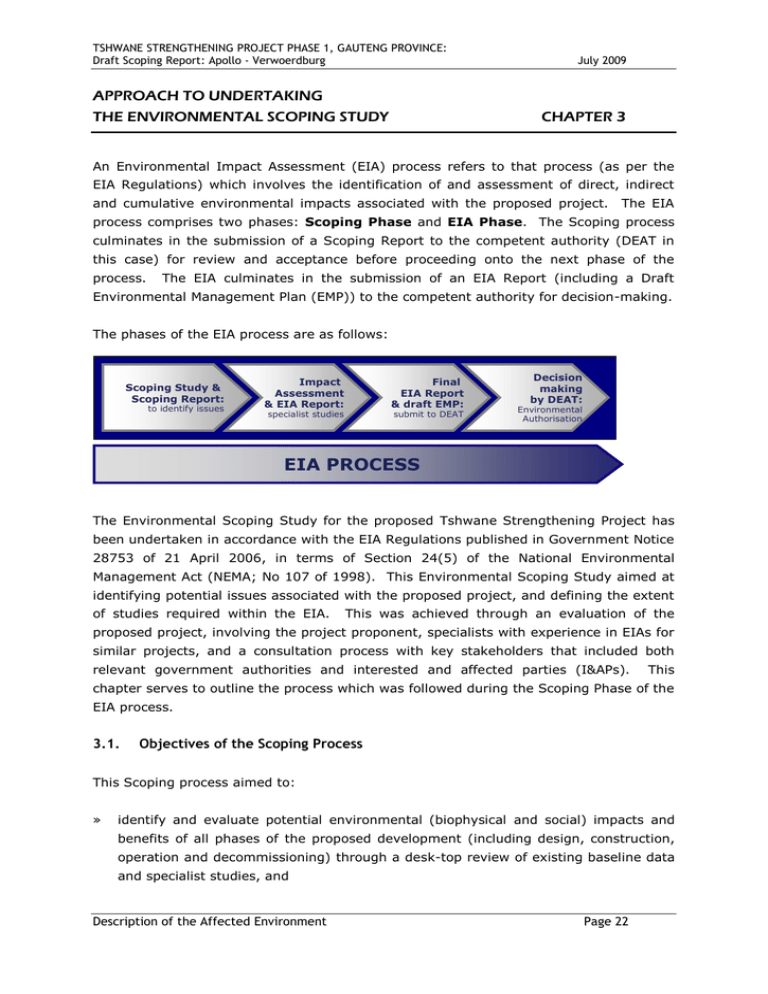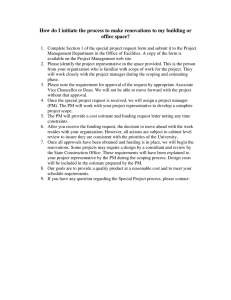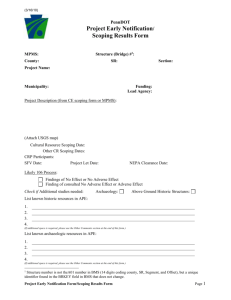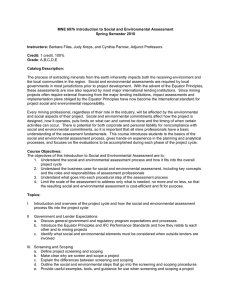Document 14939140
advertisement

TSHWANE STRENGTHENING PROJECT PHASE 1, GAUTENG PROVINCE: Draft Scoping Report: Apollo - Verwoerdburg July 2009 APPROACH TO UNDERTAKING THE ENVIRONMENTAL SCOPING STUDY CHAPTER 3 An Environmental Impact Assessment (EIA) process refers to that process (as per the EIA Regulations) which involves the identification of and assessment of direct, indirect and cumulative environmental impacts associated with the proposed project. The EIA process comprises two phases: Scoping Phase and EIA Phase. The Scoping process culminates in the submission of a Scoping Report to the competent authority (DEAT in this case) for review and acceptance before proceeding onto the next phase of the process. The EIA culminates in the submission of an EIA Report (including a Draft Environmental Management Plan (EMP)) to the competent authority for decision-making. The phases of the EIA process are as follows: Scoping Study & Scoping Report: to identify issues Impact Assessment & EIA Report: Final EIA Report & draft EMP: specialist studies submit to DEAT Decision making by DEAT: Environmental Authorisation EIA PROCESS The Environmental Scoping Study for the proposed Tshwane Strengthening Project has been undertaken in accordance with the EIA Regulations published in Government Notice 28753 of 21 April 2006, in terms of Section 24(5) of the National Environmental Management Act (NEMA; No 107 of 1998). This Environmental Scoping Study aimed at identifying potential issues associated with the proposed project, and defining the extent of studies required within the EIA. This was achieved through an evaluation of the proposed project, involving the project proponent, specialists with experience in EIAs for similar projects, and a consultation process with key stakeholders that included both relevant government authorities and interested and affected parties (I&APs). This chapter serves to outline the process which was followed during the Scoping Phase of the EIA process. 3.1. Objectives of the Scoping Process This Scoping process aimed to: » identify and evaluate potential environmental (biophysical and social) impacts and benefits of all phases of the proposed development (including design, construction, operation and decommissioning) through a desk-top review of existing baseline data and specialist studies, and Description of the Affected Environment Page 22 TSHWANE STRENGTHENING PROJECT PHASE 1, GAUTENG PROVINCE: Draft Scoping Report: Apollo - Verwoerdburg » July 2009 to provide the authorities with sufficient information in order to make a decision regarding the scope of issues to be addressed in the EIA process, as well as regarding the scope and extent of specialist studies that will be required to be undertaken as part of the EIA Phase of the process. The objectives of the Scoping process were to: » Clarify the scope and nature of the proposed activities and the reasonable and feasible alternatives to be considered within the EIA process; » Ensure due consideration of alternative options in regard to the proposed development, including the ‘do nothing’ option; » Identify and evaluate key issues associated with the proposed project and identify issues to be addressed in the Environmental Impact Assessment Phase of the EIA, through a process of broad-based consultation with stakeholders and desk-top specialist studies; and » Conduct an open, participatory and transparent public participation process and facilitate the inclusion of stakeholders’ concerns regarding the proposed project in the decision-making process. 3.2. Overview of the Environmental Scoping Process undertaken for the Proposed Tshwane Strengthening Project Key tasks undertaken within the environmental scoping process included: » Consultation with relevant decision-making and regulating authorities. » Submission of a completed application form for authorisation in terms of Government Notice No. R.385 of 2006 to the competent authority. » Undertaking of a public participation process throughout the Scoping process in accordance with the EIA Regulations in order to identify issues and concerns associated with the proposed project. » Preparation of a Draft Scoping Report and Plan of Study for EIA in accordance with the requirements of the EIA Regulations. » Preparation of a Comments and Responses Report detailing key issues raised by I&APs as part of the EIA Process. These tasks are discussed in detail below. 3.2.1. Authority Consultation and Application for Authorisation in terms of GN No R385 of 2006 As Eskom is a Statutory body (i.e. an Organ of State), the National Department of Environmental Affairs and Tourism (DEAT) will act as the relevant competent authority for this proposed project. As the project falls within the Gauteng Province, the Gauteng Department of Agriculture, Conservation and Environment (GDACE) will act as a Description of the Affected Environment Page 23 TSHWANE STRENGTHENING PROJECT PHASE 1, GAUTENG PROVINCE: Draft Scoping Report: Apollo - Verwoerdburg commenting authority for the project. July 2009 Consultation with these authorities has been undertaken throughout the Scoping process. This consultation has included the following: » Pre-application consultation regarding the proposed project and the EIA process to be undertaken. » Submission of an application for authorisation to DEAT, with a copy submitted to GDACE. These application was approved and the reference numbers 12/12/20/1470 (Apollo-Verwoerdburg substation and 2x loop-in power lines). Authorisation was thus granted to continue with the Scoping Phase of the project. » A consultation meeting with DEAT and the City of Tshwane Metropolitan Municipality has taken place to discuss the proposed project. » Follow-up consultation with DEAT and GDACE once the final scoping report has been submitted in order to discuss the alternatives identified, public consultation process undertaken and the issues identified for consideration in the EIA process. A record of all authority consultation undertaken within the Scoping Phase is included within Appendix B. 3.2.2. Notification of the EIA Process Application for exemption from complying with Regulation 56 (b) (i) and (ii), Chapter 6 of the GN R385 in Government Gazette No 28753 of 21 April 2006 (Regulations published in terms of Chapter 5 of the National Environmental Management Act (NEMA), Act No 107 of 1998) has been requested from DEAT (refer to Appendix B). This regulation requires that (i) written notice is to be given to owners and occupiers of land adjacent to the site where the activity is or is to be undertaken and (ii) the owners and occupiers of land within 100 metres of the boundary of the site or alternative site who are or may be directly affected by the activity. In terms of notification of landowners and occupiers on the proposed power line routes, the following activities have been undertaken in order to provide them the opportunity to become involved in the proposed project and the EIA being conducted: » Advertisements have been placed in local, regional and national newspapers announcing availability of the Draft Scoping Report for public review and inviting interested and affected parties to become involved in the project (as detailed below). » Notice boards were placed in the area of concern during the announcement of the project (as detailed below). » Written notices and Background Information Documents (BIDs) were distributed and placed at public places, send to the relevant municipal officials and councillors, several community organisations as well as councillors of the area as part of the public participation process for the project (as detailed in Section 3.2.4 below). Description of the Affected Environment Page 24 TSHWANE STRENGTHENING PROJECT PHASE 1, GAUTENG PROVINCE: Draft Scoping Report: Apollo - Verwoerdburg » July 2009 Focus group and Public meetings will be held in the scoping phase (as detailed below), and will be held in the EIA phase of the project at appropriate locations within the study area. Public meetings were advertised in local and regional newspapers and registered parties were invited to attend these meetings by letter (as detailed in section 3.2.4 below). In order to notify and inform the public of the proposed project and invite members of the public to register as interested and affected parties (I&APs), the project and EIA process was advertised in local, regional and national publications, as follows: » Rekord Noord » Rekord Wes » Pretoria News » The Daily Sun In addition, site adverts have been at various locations throughout the study area, i.e.: » Irene community Library » Rietvlei Nature Reserve » Centurion Community Library » Verwoerdburg substation » Apollo substation In addition to the above advertisements and notices, key stakeholders were notified of the commencement of the EIA process, including: » Municipalities City of Tshwane Metropolitan Municipality Kungwini Local Municipality » Organs of State Department of Energy (DE) Department of Transport and Roads Department of Public Works (DPW) Department of Water Affairs and Forestry (DWAF) South African Heritage Resource Agency (SAHRA) In addition to the above advertisements and notices, detailed maps (at a scale of 1:50 000 and 1:250 000) showing the proposed substation site and alternative transmission power line corridors were forwarded to key parties (such as representatives of the Friends of Magaliesburg). In addition, these maps will be made available on the Savannah Environmental webpage. Stakeholders will be notified of the availability of these maps by letter. Description of the Affected Environment Page 25 TSHWANE STRENGTHENING PROJECT PHASE 1, GAUTENG PROVINCE: Draft Scoping Report: Apollo - Verwoerdburg July 2009 Copies of the notifications distributed are contained in Appendix C of this report. 3.2.3. I&AP identification, Registration and the Creation of an Electronic Database The first step in the public participation process was to identify key stakeholders and Interested and/or Affected Parties (I&APs). existing contacts and databases, This process was undertaken through responses to advertisements, and networking with affected parties. site notices and newspaper Stakeholder groups identified include: » Provincial and local government departments (including DEAT, GDACE, SAHRA, DWAF, and Kungwini Local Municipality, City of Tshwane Metropolitan Municipality, etc) » Government Structures (including the Provincial Roads Authority, Tshwane and Kungwini Municipal planning departments, etc) » Potentially affected and neighbouring landowners on all proposed alternative routes » Industry All I&AP information (including contact details), together with dates and details of consultations and a record of all issues raised will be recorded within a comprehensive database of affected parties. While I&APs have been encouraged to register their interest in the project from the start of the process, following the public announcements, the identification and registration of I&APs will be ongoing for the duration of the EIA process. The project database will, therefore, be updated on an on-going basis throughout the project process, and will act as a record of the communication and involvement process. 3.2.4. Public Involvement and Consultation The public involvement and consultation process during the Scoping process is being undertaken by Savannah Environmental. This process was designed to provide sufficient and accessible information to I&APs in an objective manner to assist them to: » Raise issues of concern and suggestions for enhanced benefits and alternatives; » Assist the environmental specialist in identifying issues that needs to be assessed during the scoping phase; and » Verify that their issues have been captured. In order to provide information regarding the proposed project and the EIA process, a background information document (BID) for the project was compiled at the outset of the process (refer to Appendix E). Description of the Affected Environment Page 26 TSHWANE STRENGTHENING PROJECT PHASE 1, GAUTENG PROVINCE: Draft Scoping Report: Apollo - Verwoerdburg July 2009 The BID has been distributed to all identified stakeholders and I&APs together with a map and a comment sheet inviting I&APs to register for the proposed project and to submit their issues and concerns in writing to Savannah Environmental. Through consultation with key stakeholders and I&APs, issues for inclusion within the issues-based scoping study were identified and confirmed. In order to accommodate the varying needs of stakeholders and I&APs within the study area, as well as capture their views, issues and concerns regarding the project, various opportunities were provided for I&APs to have their issues noted prior to the release of the Draft Scoping Report for public review, as follows: » Focus group meetings » One-on-one consultation meetings » Telephonic consultation sessions » Written, faxed or email correspondence Networking with I&APs will continue through-out the duration of the EIA process. A landowner consultation map indicating the landowners identified to be contacted during the public participation process for the project was compiled (refer to Appendix E). This map indicates the landowners in the study area identified and consulted. 3.2.5. Identification and Recording of Issues and Concerns Issues and concerns raised by I&APs during the scoping process will be synthesised into the Comments and Responses Report. The Comments and Response Report includes responses from members of the EIA project team and the project proponent where possible. In general, the responses indicate how the issues will be addressed in the EIA process. In some cases, immediate responses and clarification have been provided. Where issues are raised that the EIA team considers beyond the scope and purpose of this EIA process, clear reasoning for this view has been provided. 3.2.6. Evaluation of Issues Identified through the Scoping Process Potential direct, indirect and cumulative impacts associated with the proposed project identified within the Scoping process have been evaluated through desktop studies as well as limited site investigation. In evaluating potential impacts, Savannah Environmental has been assisted by the following specialist team members: Specialist Riaan Robbeson Bathusi Area of Expertise of Biodiversity Environmental Consulting Description of the Affected Environment Qualifications & experience MSc (Plant Ecology) 8 years experience South African Council of Natural Page 27 TSHWANE STRENGTHENING PROJECT PHASE 1, GAUTENG PROVINCE: Draft Scoping Report: Apollo - Verwoerdburg Specialist Area of Expertise July 2009 Qualifications & experience Scientific Professions (SACNASP) (Ecological Scientist & Botanical Scientist, Reg no: 400005/03) Luke Strugnell of Avifauna BSc (Environmental Management) Endangered Wildlife Trust Jon Smallie of Endangered 3 years experience Avifauna BSC – Agriculture (Hons) Wildlife Trust 8 years experience Julius Pistorius Heritage sites D Phil Archaeology Member of Southern the Association African of Professional Archaeologists (ASAPA) Member of the South African Archaeological Society 28 years experience Lourens du Plessis of MetroGIS Visual Impact Assessment & GIS BA (Geography and Anthropology) 11 years experience in GIS and visual impact assessments Garry Patterson of ARC Agricultural Impact Institute for Soil, Climate 10 years experience in soil and water studies and Water Anita Bron of MasterQ Social Impact Assessment, MA (Research Psychology), MA land (Social Impact Assessment – in tourism process), BA Hons (Psychology), potential assessment BA (Psychology, Criminology and use & Penology) Member of Monitoring the South and African Evaluation Association and the IAIA 7 years experience Nonka Byker of MasterQ Social Impact Assessment, use & land tourism potential assessment B. Psych NQF Assessor (Institute for People Development, 2005) Member of the Health Professions Council of South Africa (PRC 0000396) 3 years experience In order to evaluate issues and assign an order of priority, it was necessary to identify the characteristics of each potential issue/impact: » the nature, which includes a description of what causes the effect, what will be affected and how it will be affected » the extent, wherein it is indicated whether the impact will be local (limited to the immediate area or site of development) or regional Description of the Affected Environment Page 28 TSHWANE STRENGTHENING PROJECT PHASE 1, GAUTENG PROVINCE: Draft Scoping Report: Apollo - Verwoerdburg July 2009 The evaluation of the issues resulted in a statement regarding the potential significance of the identified issues, as well as recommendations regarding further studies required within an EIA. Specialist Scoping Reports are contained within Appendices F –J. 3.2.7. Public Review of Draft Scoping Report and Feedback Meeting This is the current stage of the Scoping process. The draft Scoping Report will be made available for review from 20 July 2009 to 19 August 2009 at the following locations: Centurion Community Library City of Tshwane Metropolitan Municipality Kungwini Local Municipality Irene Branch Library Rietvlei Nature Reserve www.savannahsa.com www.eskom.co.za/eia Affected parties and stakeholders will also receive CDs containing the report, on request. The Executive Summary has been translated into Tswana and Afrikaans, and is available on request. The availability and duration of the Public Review process will be advertised in Rekord Noord, Rekord Wes, Pretoria News and The Daily Sun. In addition, all registered I&APs will be notified of the availability of the report in writing (refer to Appendix C). Description of the Affected Environment Page 29 TSHWANE STRENGTHENING PROJECT PHASE 1, GAUTENG PROVINCE: Draft Scoping Report: Apollo - Verwoerdburg July 2009 3.2.8. Final Scoping Report The final stage in the Scoping Study process will entail the capturing of responses from I&APs on the draft Scoping Report in order to refine this report. It is this final report upon which the decision-making Environmental Authorities provide comment, recommendations and acceptance to undertake the EIA phase of the process. 3.3. Legislation and guidelines that have informed the preparation of this report The scope and content of this Draft Scoping Report has primarily been informed by the following legislation and guidelines: » National Environmental Management Act (NEMA; Act No 107 of 1998) » EIA Regulations, published under Chapter 5 of the NEMA (GN R385, GN R 386 and GN R387 in Government Gazette 28753 of 21 April 2006) » Guidelines published in terms of the NEMA EIA Regulations, in particular: Guideline 3: General Guide to Environmental Impact Assessment Regulations, 2006 (DEAT, June 2006); Guideline 4: Public Participation in support of the Environmental Impact Assessment Regulations, 2006 (DEAT, May 2006); and Guideline 5: Assessment of alternatives and impacts in support of the Environmental Impact Assessment Regulations, 2006 (DEAT, June 2006). Several other Acts, standards or guidelines have also informed the scope of issues to be addressed in the EIA (particularly in terms of the scope and methodology of specialist studies). An initial listing of such legislation is provided in Table 3.1. A more detailed review and assessment of legislative requirements applicable to the proposed project, the specialist studies and this EIA process will be undertaken in the EIA phase. Table 3.1: Initial review of relevant policies, legislation, guidelines and standards applicable to the Tshwane Strengthening Project EIA Legislation Applicable Sections Constitution of the Republic of South Africa » Bill of Rights (S2) (Act No 108 of 1996) » Environmental Rights (S24) – i.e. the right to an environment which is not harmful to health and well-being » Rights to freedom of movement and residence (S22) National Environmental Management (Act No 107 of 1998) Act » Property rights (S25) » Access to information (S32) » Right to just administrative action (S33) » Strategic environmental management goals and objectives of the government applicable throughout the Republic to the actions of all organs of state that Description of the Affected Environment Page 30 TSHWANE STRENGTHENING PROJECT PHASE 1, GAUTENG PROVINCE: Draft Scoping Report: Apollo - Verwoerdburg Legislation July 2009 Applicable Sections may significantly affect the environment (S2) » NEMA EIA Regulations (GN R385, 386 & 387 of 21 April 2006) (Chapter 5) » Duty of Care reasonable (S28) requiring measures are that taken to prevent pollution or degradation from occurring, continuing or recurring, or, where this is not possible, to minimise & rectify pollution or degradation of the environment » Procedures to be followed in the event of an emergency incident which may impact on the environment (S30) National Heritage Resources Act (Act No 25 » of 1999) Stipulates assessment categories of criteria heritage and resources according to their significance (S7) » Provides for archaeological the protection and of all palaeontological sites, and meteorites (S35) » Provides for the conservation and care of cemeteries and graves by SAHRA where this is not the responsibility of any other authority (S36) » Requires the compilation of a Conservation Management Plan as well as a permit from SAHRA for the presentation of archaeological sites as part of tourism attraction (S44) Conservation of Agricultural Resources Act » (Act No 43 of 1983) Prohibition of the spreading of weeds (S5) » Classification of categories of weeds & invader plants (Regulation 15 of GN R1048) » Requirement to implement control measures for alien and invasive plant species (Regulation 15E of GN R1048) National Water Act (Act No 36 of 1998) » Duty of Care to prevent and remedy the effects of pollution to water resources (S19) » Procedures to be followed in the event of an emergency incident which may impact on a water resource (S20) » Water use license (S21), if required for construction purposes National Forest Act (Act No 84 of 1998) » Protected tree species – Part 3 (S12 – S16) Description of the Affected Environment Page 31 TSHWANE STRENGTHENING PROJECT PHASE 1, GAUTENG PROVINCE: Draft Scoping Report: Apollo - Verwoerdburg Legislation July 2009 Applicable Sections Conservation of Agricultural Resources Act » (No 43 of 1983) GN R1048 of 1984 - Regulations relating to weeds and invaders » Gen Notice 2485 of 1999 – Categories of weeds and invaders National Environmental Management: » Biodiversity Act (No 10 of 2004) Chapter 4 - threatened or protected ecosystems and species » Chapter 5 - species and organisms posing potential threats to biodiversity » Chapter 7 – permits relating to listed threatened or protected species in terms of section 57(1); alien species in terms of section 65(1); or listed invasive species in terms of section 71(1) » No R 151 in Government Gazette 29657 of 23 February 2007 – lists of critically endangered, endangered, vulnerable and protected species. Description of the Affected Environment Page 32





